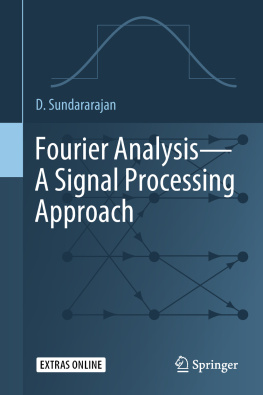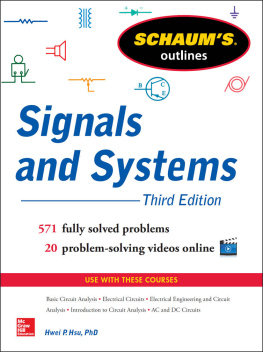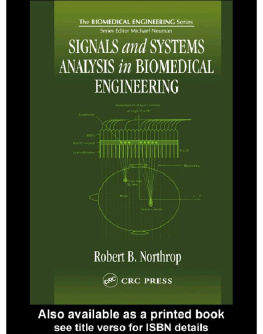Orhan Gazi
Electronic & Communication Engineering Department, Cankaya University, Ankara, Turkey
ISBN 978-3-031-17788-0 e-ISBN 978-3-031-17789-7
https://doi.org/10.1007/978-3-031-17789-7
The Editor(s) (if applicable) and The Author(s), under exclusive license to Springer Nature Switzerland AG 2023
This work is subject to copyright. All rights are solely and exclusively licensed by the Publisher, whether the whole or part of the material is concerned, specifically the rights of translation, reprinting, reuse of illustrations, recitation, broadcasting, reproduction on microfilms or in any other physical way, and transmission or information storage and retrieval, electronic adaptation, computer software, or by similar or dissimilar methodology now known or hereafter developed.
The use of general descriptive names, registered names, trademarks, service marks, etc. in this publication does not imply, even in the absence of a specific statement, that such names are exempt from the relevant protective laws and regulations and therefore free for general use.
The publisher, the authors, and the editors are safe to assume that the advice and information in this book are believed to be true and accurate at the date of publication. Neither the publisher nor the authors or the editors give a warranty, expressed or implied, with respect to the material contained herein or for any errors or omissions that may have been made. The publisher remains neutral with regard to jurisdictional claims in published maps and institutional affiliations.
This Springer imprint is published by the registered company Springer Nature Switzerland AG
The registered company address is: Gewerbestrasse 11, 6330 Cham, Switzerland
Preface
The book contains the basic concepts of signals and systems and is written for undergraduate engineering students. The topics covered in this book can be taught in a one-semester course. The reader of this book should have a strong knowledge of calculus. Integration, differentiation, and summation operations taught in calculus must be very well known. During the writing of this book, we decided to rewrite some formulas instead of referring to the page where the formula has been defined. The main reason for this is that the reader could get distracted by turning away from the page they are on to read the referred formula. We tried to include as many solved examples as possible in each chapter of the book. The reader should study and understand these examples very well.
In Chap..
In Chap. , the practical applications illustrating the use of discrete Fourier transform are provided.
Orhan Gazi
The Author(s), under exclusive license to Springer Nature Switzerland AG 2023
O. Gazi Principles of Signals and Systems https://doi.org/10.1007/978-3-031-17789-7_1
1. Introduction to Signals and Systems
Orhan Gazi
(1)
Electronic & Communication Engineering Department, Cankaya University, Ankara, Turkey
A signal can be defined as a physical phenomenon that carries information. Examples of signals are human voice, electromagnetic waves, and sonar waves. Any quantity does not necessarily have to be in a waveform type to be considered as a signal. For example, Indians in ancient times used smoke to report any danger. The smoke used here is the signal carrier, and the shape of the smoke contains information. To give another example, let us say two persons are sitting in a room and one of these persons wants to describe an item to the other. For this, he only makes movements with his hands and tries to describe the item. We can accept the hands of the person as signal carriers and meaningful movements as signal. However, since movements containing meaning have to be with the carrier, in this case, we can accept the persons hands and the movements of the hands containing meaning as signal. Even a blink event and a facial expression can be given as an example of a signal. Signals change over time, and some are defined over a period of time. In order to show the changes of signals over time, it is necessary to describe them with some mathematical functions. The mathematical function used describes the changes in the signal over time and becomes a kind of synonym for the signal. For example, the mathematical expression
can be called both a sine function and a sine signal.
In this book, we will use the signal word and its corresponding mathematical function name interchangeably. Electromagnetic waves are one of the most common types of signals used today. Electromagnetic wave is used to transfer information from one place to another. The electromagnetic wave is the preferred type of signal carrier in the world of communication because it spreads with the speed of light and has the ability to pass through solid objects. Apart from this, laser or infrared signals are also used in short-distance communication systems.
The electromagnetic wave has a sinusoidal graph of change. To send the information with this wave, we change the shape of the wave according to the information. For each different information, the wave takes a new shape. In this way, the information-loaded wave acquires the signal feature and is used for communication. Communication can be of two types which are analog communication and digital (digital) communication. The communication systems used in the past are based on analog communication. Today, digital communication systems are mostly preferred. In analog communication, the amplitude, frequency, and phase of the electromagnetic wave are changed according to the information wave, and the communication is performed. In digital communication, the continuous time data wave is first sampled. In other words, samples are taken from the data wave at certain time instances within a certain period of time. Each sample is expressed by a real number.
Real numbers are quantized to obtain integers, and their binary equivalents are calculated. For this purpose, a fixed number of bits can be used, for example, 8 bits. Later, groups of bits in the binary system are converted into data waves using square waves, analog modulation is performed, and the resulting wave is transmitted through an antenna. The steps of digital communication are shown in baseband in Fig..

A flow diagram of the conversion of the analog signal into binary and is transmitted in 4 steps. The signal is received via an antenna and converted into decimal and digital analog.
















